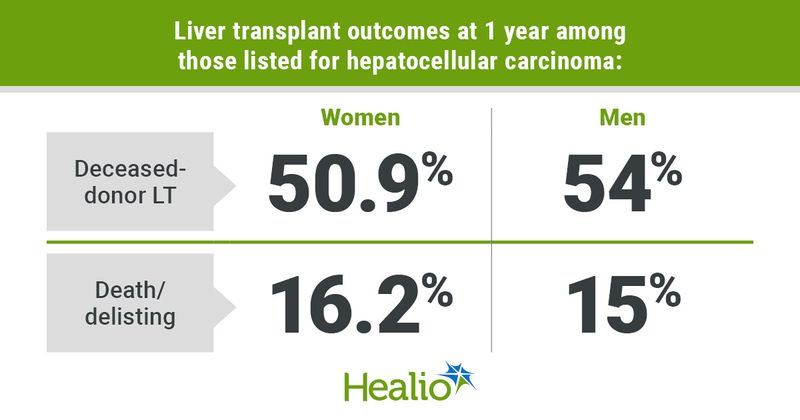Women 8% less likely than men to receive a liver transplant, possibly due to candidate size
Key takeaways:
- Women with HCC were 8% less likely than men to receive a liver transplant and 6% more likely to die or be removed from the waitlist.
- However, short women were still less likely to undergo LT vs. short men.
Women with hepatocellular carcinoma were less likely to receive a liver transplant and more likely to die or be removed from the waitlist vs. men, underscoring the need for changes to allocation policies, according to researchers.
“Women with end-stage liver disease awaiting liver transplant are less likely to undergo a transplant and more likely to die while on the waiting list compared with men,” David C. Cron, MD, MS, a research fellow and general surgery resident at Massachusetts General Hospital, and colleagues wrote in JAMA Surgery. “In response to this disparity, MELD 3.0 was recently implemented, which incorporates sex and an upper limit of creatinine and is expected to improve access to liver transplant for women.”

They continued: “However, it is unclear whether access to transplant differs by sex for waitlisted candidates with HCC.”
To determine whether disparities exist by sex or candidate size in this patient population, Cron and colleagues used the Scientific Registry of Transplant Recipients to conduct a retrospective study of 31,725 adult patients (mean age, 61.2 years; 76.3% men) waitlisted for LT and receiving exception scores for HCC between January 2010 and March 2023.
The primary outcomes were receipt of deceased-donor LT (DDLT) and death or waitlist removal due to health deterioration, which the researchers estimated using multivariable competing-risks regression.
According to study results, women had a significantly lower 1-year cumulative incidence of DDLT compared with men (50.8% vs. 54%) and a significantly higher 1-year cumulative incidence of death or delisting (16.2% vs. 15%). After adjusting for factors other than size, the researchers reported that women still had a lower incidence of DDLT (subdistribution HR = 0.92; 95% CI, 0.89-0.95) and a higher incidence of death or delisting (sHR = 1.06; 95% CI, 1-1.13).
However, after adjusting for candidate height and weight, the researchers did not observe an association between female sex and incidences of DDLT or death or delisting (sHR = 0.96; 95% CI, 0.89-1.04). But, when grouping candidates by height (< 166 cm and 166 cm), they reported that shorter women were still less likely to undergo DDLT vs. shorter men (sHR = 0.94; 95% CI, 0.88-1), a finding that was not observed among taller patients (sHR = 0.94; 95% CI, 0.88-1.01).
“Compared with men, women had an 8% lower incidence of DDLT and 6% higher incidence of death or waiting list removal,” Cron and colleagues wrote. “This disparity may be largely explained by the smaller size of female candidates, which limits the number of suitable donors. Therefore, additional solutions to the sex-based disparity should include efforts to improve access to size-appropriate donor livers for smaller candidates regardless of sex.”
